Bird ringing
Bird ringing or bird banding is the attachment of a small, individually numbered metal or plastic tag to the leg or wing of a wild bird to enable individual identification. This helps in keeping track of the movements of the bird and its life history. It is common to take measurements and examine conditions of feather molt, subcutaneous fat, age indications and sex during capture for ringing. The subsequent recapture or recovery of the bird can provide information on migration, longevity, mortality, population, territoriality, feeding behavior, and other aspects that are studied by ornithologists. Other methods of marking birds may also be used to allow for field based identification that does not require capture.[1]


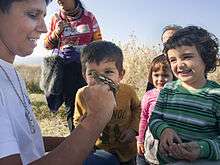
History
The earliest recorded attempts to mark birds were made by Roman soldiers. For instance during the Punic Wars in 218 BC a crow was released by a besieged garrison (which suggests that this was an established practice). Quintus Fabius Pictor used a thread on the bird's leg to send a message back. Or in another case in history a knight interested in chariot races during the time of Pliny (AD 1) took crows to Volterra, 135 miles (217 km) away and released the crows with information on the race winners.[2]
Falconers in the Middle Ages would fit plates on their falcons with seals of their owners. From around 1560 or so, swans were marked with a swan mark, a nick on the bill.[3][4]
Storks injured by arrows (termed as pfeilstorch in German) traceable to African tribes were found in Germany in 1822 and constituted some of the earliest evidence of long distance migration in European birds.[5]
In North America John James Audubon and Ernest Thompson Seton were pioneers although their method of marking birds was different from modern ringing. In order to determine if the same bird would return to his farm, Audubon tied silver threads onto the legs of young eastern phoebes in 1805 (although the veracity of the dates has been questioned[6]), while Seton marked snow buntings in Manitoba with ink in 1882.[7] Ringing of birds for more extensive scientific purposes was started in 1899 by Hans Christian Cornelius Mortensen, a Danish schoolteacher, using aluminium rings on European starlings (Mortensen had tried using zinc rings as early as 1890 but found these were too heavy).[8] The first banding scheme was established in Germany by Johannes Thienemann in 1903 at the Rossitten Bird Observatory on the Baltic Coast of East Prussia. This was followed by Hungary in 1908, Great Britain in 1909 (by Arthur Landsborough Thomson in Aberdeen and Harry Witherby in England), Yugoslavia in 1910 and the Scandinavian countries between 1911 and 1914.[9] Paul Bartsch of the Smithsonian Institution is credited with the first modern banding in the U.S.: he banded 23 black-crowned night herons in 1902.[10][11][12] Leon J. Cole of the University of Wisconsin founded the American Bird Banding Association in 1909; this organization oversaw banding until the establishment of federal programs in the U.S. (1920) and Canada (1923) pursuant to the Migratory Bird Treaty of 1918.[12]
Terminology and techniques

Bird ringing is the term used in the UK and in some other parts of Europe. Bird banding is the term used in the US. Organised ringing efforts are called ringing or banding schemes, and the organisations that run them are ringing or banding authorities. (Birds are ringed rather than rung) Those who ring or band birds are known as ringers or banders, and they are typically active at ringing or banding stations.
Birds may be captured by being taken as young birds at the nest, or as adults, captured in fine mist nets, baited traps, Heligoland traps, drag nets, cannon nets, or by other methods. Raptors may be caught by many methods, including bal-chatri traps.
When a bird is caught, a ring of suitable size (usually made of aluminium or other lightweight material) is attached to the bird's leg, has a unique number, and a contact address. The bird is often weighed and measured, examined for data relevant to the ringer's project, and then released. The rings are very light, and are designed to have no adverse effect on the birds – indeed, the whole basis of using ringing to gain data about the birds is that ringed birds should behave in all respects in the same way as the unringed population. The birds so tagged can then be identified when they are re-trapped, or found dead, later.
When a ringed bird is found, and the ring number read and reported back to the ringer or ringing authority, this is termed a ringing recovery or control. The finder can contact the address on the ring, give the unique number, and be told the known history of the bird's movements. Some national ringing/banding authorities also accept reports by phone or on official web sites.
The organising body, by collating many such reports, can then determine patterns of bird movements for large populations. Non-ringing/banding scientists can also obtain data for use in bird-related research.
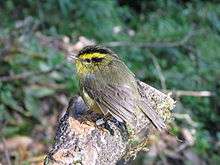
At times in North America, the bands have just a unique number (without an address) that is recorded along with other identifying information on the bird. If the bird is recaptured the number on the band is recorded (along with other identifying characteristics) as a retrap. All band numbers and information on the individual birds are then entered into a database and the information often shared throughout North American banding operations. This way information on retrapped birds is more readily available and easy to access.
Equipment used
Introduction
When deciding on bird banding equipment one must decide what species of bird they'd like to focus on. Many of the supplies used during an operation are determined by how big a bird is. The essential equipment includes a bird identification guide, mist nets or other trapping devices, and banding pliers. A leg gauge, wing ruler, and a digital scale are also useful tools for data collection. Depending on the country, various permits are required to purchase supplies and to be allowed to place bands on the birds
Mist net
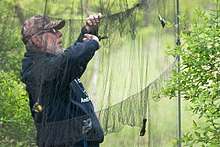
Mist net come in a variety of sizes and lengths according to the bird's size. All nets are made from a black nylon material and come with 4 shelves to catch the birds once they fly into the net. When purchasing a mist-net for sparrows the height usually stays the same at 2.7 meters but varies in width at 6 meters to 18 meters at a 30mm mesh. Determining net size for large sparrows to jays are 2.6 meters high and varying in widths at 6 meters to 18 meters at a 38mm mesh. If the study requires the banding of large owls a specific net is required and it is made with a heavier material to withstand the talons of the owl at 60mm mesh. Banding hawks also requires a heavier material at 100mm or 127mm mesh. However, some nets for larger birds include an additional shelve at 5 instead of 4.[13]
Banding pliers
Banding pliers are an essential tool that helps place the band around a bird's leg. These pliers come in different sizes as determined by how wide a bird's leg is. Pliers are sized between 0A-1A, 2–3, and 3B, 3A, and 4.[14]
Leg gauge
The band size is determined by using the leg gauge. A leg gauge is placed around the bird's leg which determines the circumference of the leg. After identifying the size of a band it is then placed on around the leg with the help from the banding pliers.[13] Most waterfowl are leg banded, while occasionally some waterfowl are banded via neck collar. In Australia, band size range from 1 to 15, plus special sizes for birds whose leg shapes require special bands, such as parrots and pelicans.[15]
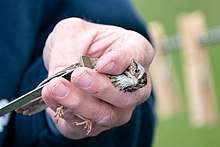
Wing ruler
When looking through the Pyle textbook some birds can be identified by the wing cord. The next essential piece of equipment is the wing ruler, which is used to determine the length of the wing for data collection, research purposes, or determining species.[13]
Digital scale
Once the processing of the bird's morphology has been completed the last piece of equipment used is a digital scale. This helps with determining the weight of the bird. This is the last step before releasing the bird.[13]
Limitations
Certain bird species are for various reasons unsuitable for ringing. In some countries, such as Australia, there exist laws prohibiting banding of such species.[15]
Many very large birds, such as ratites, flamingos and the largest swans, are extremely difficult to band because the cost of making a band which is capable of securely fitting their strong, heavy legs is prohibitive. At the other extreme, the smaller species of river and tree kingfishers, todies and certain lories, have such narrow tarsii that a band can be securely placed around the birds foot without imposing danger to blood circulation. With some gamebirds, such as the Indian peafowl, spurs on the legs interfere with the bands, which thus can cause injury to the birds.
Many species of cockatoo – which even if able to be banded require special bands to fit the unique shape of their legs – will crush bands with their powerful bills and claws.[16] The ability to overcome this problem varies between species, and with some such as the Gang-gang cockatoo, it is known to be too dangerous to attempt banding. New World vultures also cannot be banded on their legs because they urinate onto their legs, causing corrosion of the bands into a powdery oxide that sticks to the vulture's leg and injures the bird. Dippers are also dangerously handicapped by ringing because the rings induce drag that makes it extremely difficult for them to catch prey in fast-flowing water.
Among species which can be safely ringed, there are major limitations among nomadic species of the deserts of the Eastern Hemisphere and cardueline finches of the taiga. The highly unpredictable movements inherent in these species' lifestyles means that recovery rates are extremely low,[17][18] especially given generally low population densities within their habitats.
Similar schemes
Wing tags
In some surveys, involving larger birds such as eagles, brightly coloured plastic tags are attached to birds' wing feathers. Each has a letter or letters, and the combination of colour and letters uniquely identifies the bird. These can then be read in the field, through binoculars, meaning that there is no need to re-trap the birds. Because the tags are attached to feathers, they drop off when the bird moults.
Another method is imping in a brightly colored false feather instead of a natural feather.[19]
A patagial tag is a permanent tag held onto the wing by a rivet punched through the patagium.[20]
Radio transmitters and satellite-tracking
Where detailed information is needed on individual movements, tiny radio transmitters can be fitted on to birds. For small species the transmitter is carried as a 'backpack' fitted over the wing bases, and for larger species it may be attached to a tail feather or looped to the legs. Both types usually have a tiny (10 cm) flexible aerial to improve signal reception. Two field receivers (reading distance and direction) are needed to establish the bird's position using triangulation from the ground. The technique is useful for tracing individuals during landscape-level movements particularly in dense vegetation (such as tropical forests) and for shy or difficult-to-spot species, because birds can be located from a distance without visual confirmation.[21][22]
The use of satellite transmitters for bird movements is currently restricted by transmitter size – to species larger than about 400g. They may be attached to migratory birds (geese, swans, cranes, penguins etc.) or other species such as penguins that undertake long-distance movements. Individuals may be tracked by satellites for immense distances, for the lifetime of the transmitter battery. As with wing tags, the transmitters may be designed to drop off when the bird moults; or they may be recovered by recapturing the bird.[23][24]
Field-readable rings
_2.jpg)
A field-readable is a ring or rings, usually made from plastic and brightly coloured, which may also have conspicuous markings in the form of letters and/or numbers. They are used by biologists working in the field to identify individual birds without recapture and with a minimum of disturbance to their behaviour. Rings large enough to carry numbers are usually restricted to larger birds, although if necessary small extensions to the rings (leg flags) bearing the identification code allow their use on slightly smaller species. For small species (e.g. most passerines), individuals can be identified by using a combination of small rings of different colours, which are read in a specific order. Most colour-marks of this type are considered temporary (the rings degrade, fade and may be lost or removed by the birds) and individuals are usually also fitted with a permanent metal ring.
Leg-flags
Similar to coloured rings or bands are leg-flags, usually made of Darvic and used in addition to numbered metal bands. Although leg-flags may sometimes have individual codes on them, their more usual use is to code for the sites where the birds were banded in order to elucidate their migration routes and staging areas. The use of colour-coded leg-flags is part of an international program, originated in Australia in 1990, by the countries of the East Asian - Australasian Flyway to identify important areas and routes used by migratory waders.[25]
Other markers
Head and neck markers are very visible, and may be used in species where the legs are not normally visible (such as ducks and geese). Nasal discs and nasal saddles can be attached to the culmen with a pin looped through the nostrils in birds with perforate nostrils. They should not be used if they obstruct breathing. They should not be used on birds that live in icy climates, as accumulation of ice on a nasal saddle can plug the nostrils.[26] Neck collars made of expandable, non-heat-conducting plastic are very useful for larger birds such as geese.[27]
Education
Many institutions that ring birds offer demonstrations for the public, where experts ring live birds while highlighting the steps of the process and answering questions from the public.[28] Educating visitors about the technique helps to spread accurate information about it to the public.[29] While live bird ringing is not the only method of educating the public on bird conservation, it can be an especially engaging and unique method for visitors.[30]
Some results
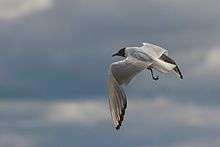
Ringing activities are often regulated by national agencies but because ringed birds may be found across countries, there are consortiums that ensure that recoveries and reports are collated. In the UK, bird ringing is organized by the British Trust for Ornithology. In North America the U.S. Bird Banding Laboratory collaborates with Canadian programs and since 1996, partners with the North American Banding Council (NABC).[31] Waterfowl hunters may report the band number of the bird they killed or observed, and find out the details of that specific bird such as breed, age, and banding location. Bird bands are often seen as a prize because they are still relatively rare. The European Union for Bird Ringing (EURING) consolidates ringing data from the various national programs in Europe.[32] In Australia, the Australian Bird and Bat Banding Scheme manages all bird and bat ringing information.[33] while SAFRING manages bird ringing activities in South Africa.[34] Bird ringing in India is managed by the Bombay Natural History Society. The National Center for Bird Conservation (CEMAVE) coordinates a national scheme for bird ringing in Brazil.[35][36][37]
See also
- Tracking animal migration
Notes
- Cottam, C (1956). "Uses of marking animals in ecological studies:marking birds for scientific purposes". Ecology. 37 (4): 675–681. doi:10.2307/1933058. JSTOR 1933058.
- Fisher, J. & Peterson, R.T. 1964. The world of birds. Doubleday & Co., Garden City, New York.
- Charles Knight (1842) The Penny Magazine of the Society for the Diffusion of Useful Knowledge: of the society for the diffusion of useful knowledge. Society for the Diffusion of Useful Knowledge (Great Britain) v.11 [n.s. v.2] (pp. 277–278)
- Schechter, Frank I. The Historical Foundations of the Law Relating to Trade-Marks. New York: Columbia University Press, 1925. p. 35
- Haffer, J. (2007). "The development of ornithology in central Europe". Journal of Ornithology. 148: 125. doi:10.1007/s10336-007-0160-2.
- Halley, Matthew R (2018). "Audubon's famous banding experiment: Fact or fiction?". Archives of Natural History. 45: 118–121. doi:10.3366/anh.2018.0487.
- North American Banding Council (2001). The North American Banders' Study Guide (PDF). Point Reyes Station, Calif.: North American Banding Council. pp. 3–4. Retrieved 18 July 2012.
- Preuss, Niels Otto (2001). "Hans Christian Cornelius Mortensen: aspects of his life and of the history of bird ringing" (PDF). Ardea. 89 (1): 1–6. Archived from the original (PDF) on 2011-07-24.
- Spencer, R. 1985. Marking. In: Campbell. B. & Lack, E. 1985. A dictionary of birds. British Ornithologists' Union. London, pp. 338–341.
- Tautin, John; Métras, Lucie (December 1988). "The North American Banding Program". EURING Newsletter. Archived from the original on 20 February 2012. Retrieved 21 May 2012.
- Tautin, John (2005). "Frederick C. Lincoln and the Formation of the North American Bird Banding Program" (PDF). In Ralph, C. John; Rich, Terrell D. (eds.). Bird Conservation Implementation and Integration in the Americas. Third International Partners in Flight Conference. 2002 March 20–24; Asilomar, California. Albany, California: U.S. Department of Agriculture, Forest Service, Pacific Southwest Research Station. pp. 813–814. Gen. Tech. Rep. GTR-PSW-191. Retrieved 21 May 2012.
- Tautin, John (2005). "One Hundred Years of Bird Banding in North America" (PDF). In Ralph, C. John; Rich, Terrell D. (eds.). Bird Conservation Implementation and Integration in the Americas. Third International Partners in Flight Conference. 2002 March 20–24; Asilomar, California. Albany, California: U.S. Department of Agriculture, Forest Service, Pacific Southwest Research Station. pp. 815–816. Gen. Tech. Rep. GTR-PSW-191. Retrieved 21 May 2012.
- "Welcome to AVINET". avinet.com. Retrieved 24 September 2015.
- "Bird Banding Laboratory". usgs.gov. Retrieved 24 September 2015.
- Australian Bird and Bat Banding Scheme; Recommended Band Size List – Birds of Australia and its Territories
- Rowley, Ian and Saunders, Denis A.; ‘Rigid Wing Tags for Cockatoos'; Corella, 1980, 4(1); pp. 1–7
- Newton, Ian; The Speciation and Biogeography of Birds; pp. 490–492 ISBN 012517375X
- Dean, Richard J.; Nomadic Desert Birds; p. 138 ISBN 3540403930
- Wright, Earl G (1939). "Marking Birds by Imping Feathers". The Journal of Wildlife Management. 3 (3): 238–239. doi:10.2307/3796107. JSTOR 3796107.
- Marion, WR; JD Shamis (1977). "An annotated bibliography of bird marking techniques" (PDF). Bird Banding. 48 (1): 42–61. doi:10.2307/4512291. JSTOR 4512291.
- Rappole, J. H. & Tipton, A. R. (1991). "New harness design for attachment of radio transmitters to small passerines". J. Field Orn. 62 (3): 335–337. JSTOR 20065798.
- Naef-Daenzer, Beat (2007). "An allometric function to fit leg-loop harnesses to terrestrial birds" (PDF). Journal of Avian Biology. 38 (3): 404–407. doi:10.1111/j.2007.0908-8857.03863.x. Archived from the original (PDF) on 2008-12-17.
- Mikael Hake; Nils Kjellén; Thomas Alerstam (2001). "Satellite tracking of Swedish Ospreys Pandion haliaetus: autumn migration routes and orientation". Journal of Avian Biology. 32 (1): 47–56. doi:10.1034/j.1600-048X.2001.320107.x.
- Kanaia, Yutaka; Ueta, Mutsuyuki; Germogenov, Nikolai; Nagendran, Meenakshi; Mita, Nagahisa & Higuchi, Hiroyoshi (2002). "Migration routes and important resting areas of Siberian cranes (Grus leucogeranus) between northeastern Siberia and China as revealed by satellite tracking" (PDF). Biological Conservation. 106 (3): 339–346. doi:10.1016/S0006-3207(01)00259-2. Archived from the original (PDF) on 2008-12-17.
- Australasian Wader Studies Group: Wader flagging Archived September 25, 2008, at the Wayback Machine
- Kobe, Michael D. (1980). "Detrimental effects of nasal saddles on male ruddy ducks" (PDF). J. Field Ornithol. 52 (2): 140–143. JSTOR 4512636.
- USGS (2003) Auxiliary markers Archived May 7, 2009, at the Wayback Machine
- "Banding Demonstrations". Braddock Bay Bird Observatory. 2013-02-26. Retrieved 2017-10-31.
- Pitkin, Melissa (2006). Mist-netting with the public: A guide for communicating science through bird banding (PDF). p. 29.
- "A Bird in the Hand is Best". www.birds.cornell.edu. Retrieved 2017-10-31.
- John Tautin and Lucie Métras (1998) The North American Banding Program Archived 2012-02-20 at the Wayback Machine. Euring Newsletter Vol 2.
- "EURING". EURING. Archived from the original on 2014-05-28. Retrieved 2014-06-02.
- ABBBS Archived July 19, 2008, at the Wayback Machine
- "Safring". Web.uct.ac.za. 2001-10-03. Archived from the original on 2012-07-21. Retrieved 2014-06-02.
- "CEMAVE". Icmbio.gov.br. Retrieved 2014-06-02.
- "Bird Banding Laboratory". usgs.gov. Retrieved 24 September 2015.
- Avinet. 2014. Bird Banding Supply Company. [Online] Available at: http://www.avinet.com/. [Accessed 27 Nov. 2014].
References
- Knox, A.G. 1982. "Ringing pioneer". BTO News No. 122, p. 8.
- Knox, A.G. 1983. "The location of the Ringing Registers of the Aberdeen University Bird-Migration Inquiry". Ringing and Migration 4: 148.
- Martin-Löf, P. (1961). "Mortality rate calculations on ringed birds with special reference to the Dunlin Calidris alpina". Arkiv för Zoologi. 2. Kungliga Svenska Vetenskapsakademien. 13 (21).
External links
| Wikimedia Commons has media related to Bird ringing. |
- Birdringing.net : A Directory of Bird Ringing and Bird Banding Websites
- A1 ID Systems: Manufacturer of electronic bird rings. (Microchip identification for animals)
- LaB O RINg Project:Birds of Western Palearctic in Hand
- Report a found band in the United States
- Official US Bird Banding Lab
- Report ringed birds online from all of the European schemes
- EURING (Co-ordinating organisation for European bird-ringing schemes)
- Canadian Migration Monitoring Network (Co-ordinates bird migration monitoring (includes bird banding) stations across Canada)
- Types and sizes of bird rings used in Poland published by the Aranea, bird rings producer.
- The North American Banding Council (NABC)
- The Institute for Bird Populations – MAPS banding Program
- BBC News of Bardsey Island, ringed 1957
- Official CEMAVE-Brazil
- Calgary Bird Banding Society
- Songbird and Hummingbird Banding Research Ohio and Indiana